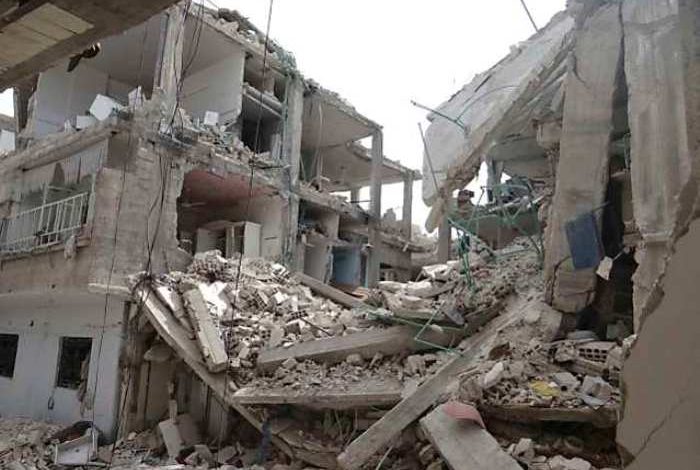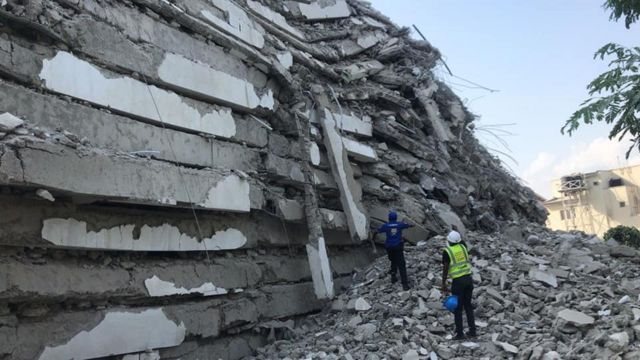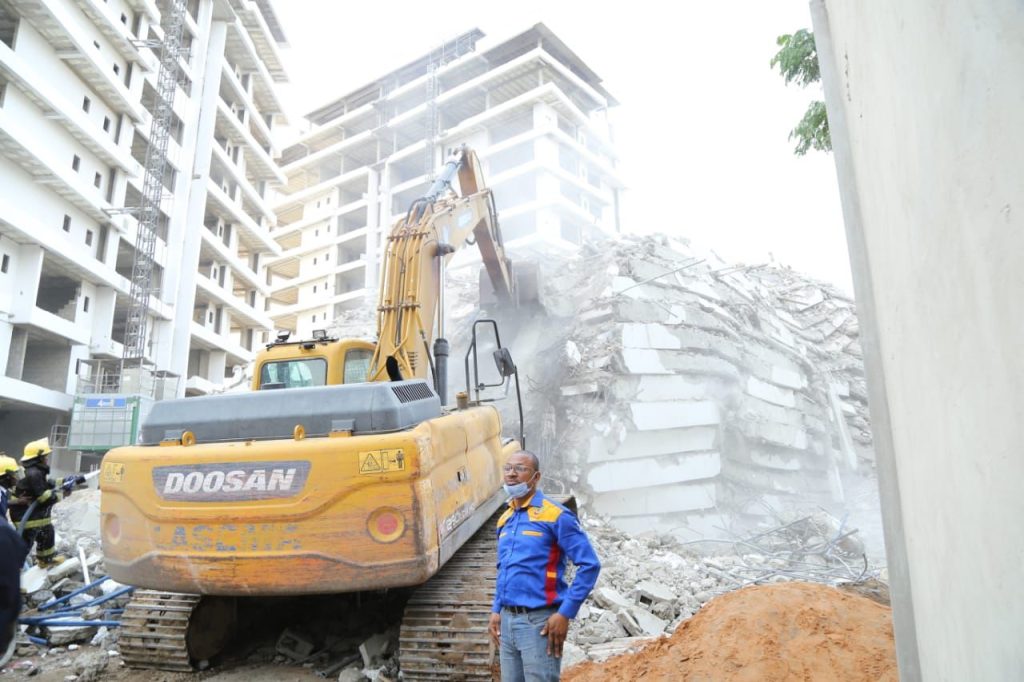
Building Collapse: Ensuring Public Safety Through Government Regulations
By: Oluwaseun Boye
The upsurge in the rate of building collapses in some parts of major cities in the country has called for great concerns. In averting further incidences, the daunting tasks can’t be left alone on the government, without the active collaboration of relevant regulatory agencies to join hands in proffering solutions.
Chiefly, the defective status of these buildings account for the increasing rate of the collapse, resulting from the use of sub-standard materials. However, a lot of people wonder why building collapse and there are no regulators to stem the tide for public health and safety.
However, when there is a total failure of building elements, then a collapse is inevitable. According to experts, collapse of a building may be either a partial, progressive and total or sudden collapse. Building collapse is common to storey buildings, not ruling out that, bungalows too cannot experience structural defect, but the impact may not be as grievous as the former.
The construction industry has been tongue-lashed by members of the public due to incessant collapse of skyscrapers, ongoing new and old, as well as newly finished construction, particularly around the African countries.

The recent of all is the collapse of a 21 -storey building on Gerrard Road, Ikoyi in Lagos State where lives were lost . In its swift response, Lagos State Government set up an independent panel to probe the collapse of the building drawing members from the Nigeria Institute of Architects (NIA), Nigerian Institute of Town Planners (NITP), Nigeria Society of Engineers (NSE) and other professional bodies.
This action will no doubt help the government to investigate the remote and immediate causes of the incident and make recommendations on how to prevent future occurrence. Be that as it may, unfortunately, the souls that have been lost to the disaster cannot be brought back to life, while families, friends and associates are left in anguish to suffer their loss, government should leave no stone unturned to find out what went wrong and punish those indicted.
There is no gainsaying the fact that the hazards caused by building collapse are of great concern to all stakeholders, and there is need for all stakeholders to brainstorm and stem the tide. Though, the activities and involvement of unskilled labour in construction industry in times past has contributed to the image battering of the construction industry, while people keep raising questions of who should take the blame.
Experts said some of the main causes of building collapse are attributed to bad design, faulty construction, foundation failure, extraordinary loads, unexpected failure modes or a combination of causes. But collapses also occur due to natural disasters, such as earthquakes, floods, hurricanes, cyclones and fires.
According to the Constructor.org, many types of failure can trigger the collapse of a reinforced concrete building. Any structure may experience a phenomenon known as structural failure or collapse. Structural failure is the total or partial loss of the structure’s integrity and its load bearing capacity. Such an incident occurs when the material of the construction exceeds its strength limits and breaks or experiences excessive deformations.
According to a Professor of Civil Engineering at Covenant University, Ota, Ogun State, Anthony Ede, at a seminar in 2016, some of the causes of collapse building, include weak or poor foundation, counterfeiting or substandard materials, use of unskilled workers and over-loading the house beyond measure. He noted two things should be considered while building; solidity of the soil and the heaviness of the building as the foundation which is the core of any structure should be made solid.
Although, some experts have various reasons some buildings collapse, but records here in Nigeria and in some African Countries agree with the submission of Professor Anthony Ede. For example, all the building collapses across Nigeria starting from 2012, 2013, 2014, 2016 and 2017 were in line with reasons given by building engineers after their findings, and pointed to weak foundations, fake materials, over-loading, corruption of the builders, in order to cut cost, and the use of unskilled labour amongst others.
When it comes to concrete buildings, the usual types of structural failure could be crushing failure of columns, where reinforced concrete columns are subjected to intense loading conditions, both steel and concrete yield and the column fails. Earthquake loads that apply lateral stresses highly affect the solidity of the column which may get crushed and lose its bearing capacity.
If the structure is isostatic the framework will behave like a mechanisms. Others could be as a result of Shear cracking of columns, that is reinforced concrete columns may undergo shear failure, mostly caused by seismic forces. The cracks usually appear diagonally and may take a spiral shape when the structure experience twisting to mention a few.
In Nigeria, investigations revealed that most ancient buildings were made of concrete which has stood the test of time as compared to modern day buildings. Findings pointed out that building collapses can occur as a result of inferior and low quality building materials, lack of supervision, inappropriate or kangaroo approvals from relevant government authorities, inexperienced labour, unemployment which result to the employment of quacks to work at building sites, to mention a few.
There are also records of building collapse across some African Countries. For example, Kenya’s capital, Nairobi, in 2016, Ugandas capital, Kampala in 2016, Ghana and some other African Countries in 2019, amongst others also agreed with the reports of poor foundations, counterfeit materials, heavy load on building, corruption and manipulation in building materials and poor government enforcement as well as inadequate monitoring.
Sincerely, the consequence of collapse building speaks volume of enforcement and inadequate building regulations which have caused destruction of thousands of property and loss of lives in a pathetic building collapse. The innumerable records of deaths in building collapse had shown disregard for public and well-being of the people.

The conclusion of many experts in curbing incessant collapse buildings in Nigeria, particularly, is for government to carry out complete enforcement and ensure that every ongoing construction be in line with government building laws and regulations. Findings revealed that the enforcement were not carried out due to bribery and corruption bedeviling the system.
For example, there are no legislation that have been put in place by Nigerian government or Nigeria Institute of Structural Engineers to stop or refrain bricklayers or technicians from calling themselves structural engineers. Many innocent Nigerians had been deceived by these charlatans and these unrestrained acts have caused grievous consequences for the socio-economic development of the nation.
Be that as it may, a proactive government will not fold its arms and allow gross ineptitude to contribute to barter its national image. Regulatory bodies such as Urban and Physical Planning Boards, Institution of Surveyors, Quantity Surveyors and other stakeholders in this field must wake up to their responsibilities by policing every ongoing construction to enforcement necessary laws and prevent unnecessary collapse and loss of lives.
The Chairman, Nigeria Institution of Surveyors, Ogun State Chapter, Surveyor Adebowale Ademola, added that building collapse may occur due to topography challenges of the area, but, irrespective of the land structure, suitability must be critically considered before designing and building hence, it could lead to collapse. He noted that, other factors could also include irregular pillars and beams for high-rise buildings, in addition to, when expansion and contraction occurs at dredging and sand filling sites. Flooding also occurs and drainage of such areas are not adequately mapped as all these could lead to collapse of buildings. Members of the public, government and other professional bodies are also charged to always ensure due process in construction industry, so as to reduce cases of collapse buildings that have reduced the nation Engineering expertise to nothing.
It was also revealed that compliance with physical planning regulations will help reduce and possibly, halt the spate of collapsed building and distressed structures with attendant protection of lives and properties. In addition, working in harmony with different stakeholders and professionals would also help to sustain development of the physical planning section of any nation.
In Ogun State, the Prince Dapo Abiodun-led government has been involving certified structural engineers in building across the State, that will not only ensure public safety, but will make life more abundant to the people, since he believed that affordable housing remained one of the means of making living more abundant.
Hence, the administration has made commitments in the provision of various housing units in different parts of the State. With this determination, government is leaving no stone unturned to ensure that the provisions meet with the expectation of the people in term of size of the land, building, affordability and the location of the project.
Government also ensures that all subsectors in the building industry, such as professionals as well as unskilled artisans are being employed and trained on site. This development also provides employment to skilled artisans in line with the administration’s Youth Employment Scheme. By training artisans on site, it is a measure of ensuring that the right human resources are engaged in building and construction.
By and large, experts believe the absence of a National Building Code which is meant to enforce rules on building construction, design, testing, inspection and maintenance to protect public health and safety has been largely responsible for the incessant incidence of collapsed buildings being witnessed across the country. And that passing the national building code into law will definitely help to regulate and stop the use of non-professionals and quacks in the building and construction industries who are also major contributors to building collapses.
In addition, there is need to ensure that contractors comply to stop the use of untested products and materials in all construction projects as a way of preventing structural defects.
Research showed that selfish interest of some property owners who desire to maximise profits do consult local bricklayers who are not certified by Nigeria Institute of Structural Engineers to build skyscrapers. It is believed there is need for public enlightenment to distinguish between artisans and certified engineers. The government, at all levels, can achieve this in collaboration with building institutes to create further enlightenment to clarify the difference in patronising them.
Oluwaseun Boye is an Information Officer with the Ogun State Ministry of Information and Strategy and writes via [email protected]
FOOTNOTE: You want to share story with us? You want to advertise with us? You need publicity for product, or service, or event? Contact us on WhatsApp +2348073463653 or email [email protected]






